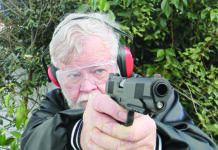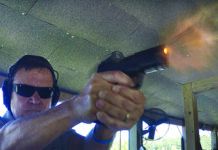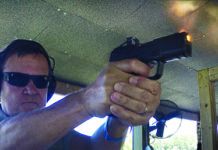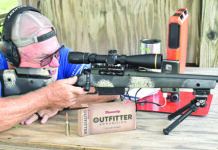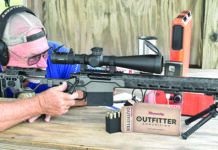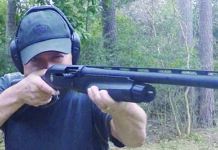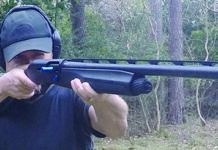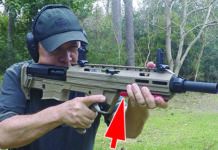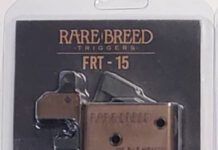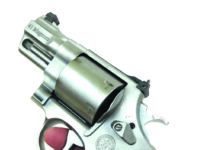Reviewing Guns
Since becoming a subscriber, I’ve been meaning to write and tell you how much I appreciate your tell-it-like-it-is style.
I’ve been a shooter and collector for many years, and have developed a “sixth sense” when reading the commerical advertising-driven gun magazines.
It is just so refreshing to hear the unvarnished, objective facts about a gun, which is a mechanical item when stripped of all its potential romance or image. Newer or less-skeptical readers must be in a virtual fog of confusion while trying to sort out all the facts surrounding the dizzying array of shooting-related products in the market place today. How ironic that just as we reach a high plateau of available consumer goods and accessories, the national culture and legal atmosphere is about to implode upon us, so that we will all look back to his recent era as the true golden age of guns and shooting.
I am amused at the trend to shrink handguns to previously unseen sizes, then have them lengthened up again by extended grip magazines. It seems to me that gun makers could have left such guns their original sizes to begin with.
Also, one reads endlessly about “one-shot-stops” in handgun combat, then in the next sentence how “double-taps” are a necessity. The contradictions elsewhere continue to amuse me, but keep up the fine work in Gun Tests.
—Art Sweisfurth
Morton, PA
Sniping On Rifles
Your November 1999 report on “Precison Rifles” is self contradictory, especially concerning the top-rated Robar. It says, “Such a rifle is supposed to put its first shot into a specific small target… there are generally no groups involved, “ and also, “The manual required the shooter to clean the barrel after no more than five shots.” But then your own actual shooting showed that “placement of the first shot was not the same as the following four shots in our five-shot groups,” and “on one target four shots (after the fouler) went into 0.19 inch.”
There was no mention of how far the second and later shots separated from the first. Or, phrased the other way, how far was that all-important first shot out of the group? Or in what direction (if reproduceable) was the first shot from the other four?
Do you or Robar recommend that such a rifle be sighted in for that first shot from a cold, clean barrel; with an effective requirement to clean every shot, not every five? Or should the user sight it in by group center, clean it, fire a fouling shot, and put it away ready for use slightly dirty?
Second, your observations of the Dakota Longbow confirm what I saw and heard of the only Dakota sporting rifle to actually be shot seriously (instead of being proudly displayed as art or traded around as a financial speculation) that I know of. A local hunter bought a Dakota in .375 H&H that could not be counted on to feed out of the magazine. Dakota could not or would not rectify it. He got the rifle in shape to take on safari (a real one, in Africa) only by taking it to a good local gunsmith, who ordered a .416 Rigby magazine follower from Dakota and remachined it to serve the .375. Then it worked properly. But only after hours of labor and trial-and-error fitting to make a $2,500 gun work.
Third, “Precison Rifle,” indeed. “Tactical rifle” is itself a euphemistic weasel word. These rifles are police sniper rifles intended for use on suspects too difficult or dangerous, or just too inconvenient to apprehend in one piece. I have no problem with their commercial sale as a matter of Constitutional right, but see no real use for them. They do not meet milspec for military sniping, are too heavy for game hunting, too riccochet prone for varmint hunting, do not meet the rules for bullseye or silhouette target shooting, and are not accurate enough for benchrest shooting. They fall into a broad class of guns that I summarize as Centerfire Plinkers. Not that I don’t own some myself. But not at $5,000 a copy.
Oh yes, and compare them with Mr. Hartz’s BOSS-equipped production-line rifles for accuracy, cost, and portability.
—James Watson
jrawatson@juno.com
Thank you for your many thoughtful questions and observations. Some folks don’t want their neighbors or fellow shooters to know they have a “sniper” rifle, so we gave them an alternate, non-military, name.
Due to space limitiations, the following was cut from my article on precision rifles:
“Precision rifles are commonly evaluated by testing their grouping capability, and although that is one of the best measures of a rifle’s ability to perform consistently, it does not mean the first shot from a clean barrel will go into the same hole as all the rest. Although the first shot is the one that counts, groups are still important because the rifle must be able to put all of its shots pretty close to where it looks. If it can’t group, it has little chance of hitting the target with the first shot.
“In our testing, we discovered that not one of these fine rifles was capable of putting the first shot from a perfectly clean barrel in exactly the same spot as subsequent shots. What this means is that the individual who shoots the rifle in the field has to determine for himself if he wants a slightly fouled barrel (one or two shots through it from perfectly clean) before he takes his “money” shot, or if he wants the barrel as clean as he can get it. The choice is ultimately the decision of the rifleman.
“If he has had military training in one-shot deployment of the rifle, he’ll probably prefer an always-clean barrel, but he will also have tested his rifle’s point of impact with a dirty barrel, and will be able to make the best use of the rifle at long range under those conditions.
“If the rifleman can expect to have to take several shots each time he puts the rifle to use, he’ll most likely be better served by a slightly fouled barrel. (This is like the benchrest shooter, who shoots one or two fouling shots from a perfectly clean barrel, then shoots for record.) This person will have trained so he knows exactly what his rifle will do, shot after shot. He also will have learned what his rifle does with that first shot from a perfectly clean barrel, if he calls himself a rifleman.
“Buyers for these rifles include police departments, SWAT teams, the military, foreign governments, and any individuals who feel a great need for one and who can afford their usually very hefty price tag.”
Your comment that these are not military-spec rifles is incorrect. These rifles are, in fact, utilized by various Spec Ops groups, and the Robar rifle was one of a shipment to a South American country for military use.
We test lots of rifles here, and these three precision machines were far and away the most consistently precise and easy-to-use rifles we’ve ever seen. I include the Dakota after its scope was tightened. How popular are they? The companies that make these $3,000 to $5,000 rifles can barely keep up with orders.
Concerning the Dakota Longbow: Yes, serial number 2 had a problem with its feed. In our experience Dakota listens well, and we’re sure they will address its feed problem. If they don’t, we’d like to hear about it. They have already solved the loose-scope-mount problem on the Longbows by going to a larger screw.
—Ray Ordorica
Bulgarian Makarovs
In the October 1999 issue, you ran an article on 9mm carry guns, including the Arsenal Bulgaria Makarov, specifically one imported by Miltex. Although there is no telling why the test weapon you used failed, I would like to note that I have owned an Arsenal Bulgaria Makarov since May 1997, and have fired at least 600 rounds through it, from Chinese ball ammo to Cor-Bon hollow points, and have had no problems (except that it did not like hollow points for about the first 300 rounds). I have a friend who also owns an Arsenal Bulgaria Makarov, and has used it for at least five years without problems.
As I mentioned, there is no telling why your test pistol failed and our pistols have not. Maybe you got a bad one, or maybe we got good ones. Or possibly the quality has gone down since the onces we own were purchased. I just thought you might find it interesting to know that there are some reliable ones of that type. As for the notes on accuracy, you were right on the nose. My Mak is one of the most accurate guns I know, and a joy to shoot. My wife has a Russian Baikal Makarov, and it is also an excellent shooter.
—John P. Hans
Bowling Green, KY
As we noted, the Mak performed well in certain areas, and if it hadn’t failed, it likely would have done well in that test of 9mm carry guns .
—Roger Eckstine
1999 Best Buys Question
The August 1999 issue compared Smith & Wesson’s 242 to the Taurus 85ULTi. As a result of your review, I bought the Taurus and like it. But in the December 1999 issue, you gave Smith & Wesson’s 342Ti your best rating. I still don’t see where it’s compensated, and what about DAO? Do you still recommend the Taurus, and if so, why not mention it?
—Steve Saiia
sjsaiia@ns.net
Yes, we still like the Taurus 85ULTi. But the S&W 342Ti was a ground-breaking product that we thought deserved special mention in our year-end summary.
—Todd Woodard
Russian Update
You may have missed a real winner in your October 1999 test of 7.62x39mm Russian rifles. I bought a Colt AR-15 in 7.62×39 with a 16-inch barrel a few years ago. I’ve never had a problem with it, and it shoots much better than it ought to. I may have gotten lucky and picked up the only one that will do it, but with its favorite handload (and a scope), it will group five shots under an inch at 100 yards. This thing positively loves the Winchester 125-grain SP with H322. Lose the scope, and it’s great for wild boar and deer in the woods.
—Name and city withheld
.444 Vs. .45-70
I greatly enjoyed (as always) reading your January 2000 comparison of the Marlin Guide Gun and the Wild West Co-Pilot. My question to you is: How do you think these rifles compare to the similar Marlin Outfitter and Winchester Timber Carbine in .444 Marlin? In the past, I would have automatically considered the .444 Marlin to be significantly more powerful than the .45-70, but with the advent of modern, more powerful loads in .45-70 (Federal has some good-looking ammo, and the Buffalo Bore loads featured in your article certainly raise the bar), that no longer seems a fair statement. Additionally, the .45-70 seems to be loaded by more manufacturers, and in greater variety, than the .444M.
—Klebert L. Hall
swamp-yankee@home.com
We hope to test the Winchester .444 against the Marlin .444 soon, and hope to learn something about the comparitive quality of the Winchester.
Although I realize some folks have good reasons to pick the .444, I would personally choose the .45-70 over the .444 because of the heavy bullets available for the .45-70. Assuming the rifle can take the pressure, the .45-70 can be handloaded to nearly equal the .458 Winchester Magnum. The heaviest bullets for the .444 of which I am aware weigh around 300 grains, perhaps a bit more. There are 600-grainers out there in .458 caliber that will work in the .45-70.
Either cartridge can be down-loaded to give barely more than a pop that ejects a round ball, so there’s not much difference on the lower end. The big difference is at the upper limits, and thus I believe the versatility of the .45-70 to be far superior to that of the .444.
As you noted, there are some truly modern loads for the .45-70 now. Besides Buffalo Bore, Cor-Bon has (or had) some doozies. Wild West will bring out a .457 Magnum soon, a very hot load that is basically the .45-70 with a slightly longer case to prevent its going into rifles that can’t handle. For more information, contact Buffalo Bore Ammunition, 100 Freeman Creek Rd., Carmen, ID 83462, telephone (208) 756-8085.
—Ray Ordorica



